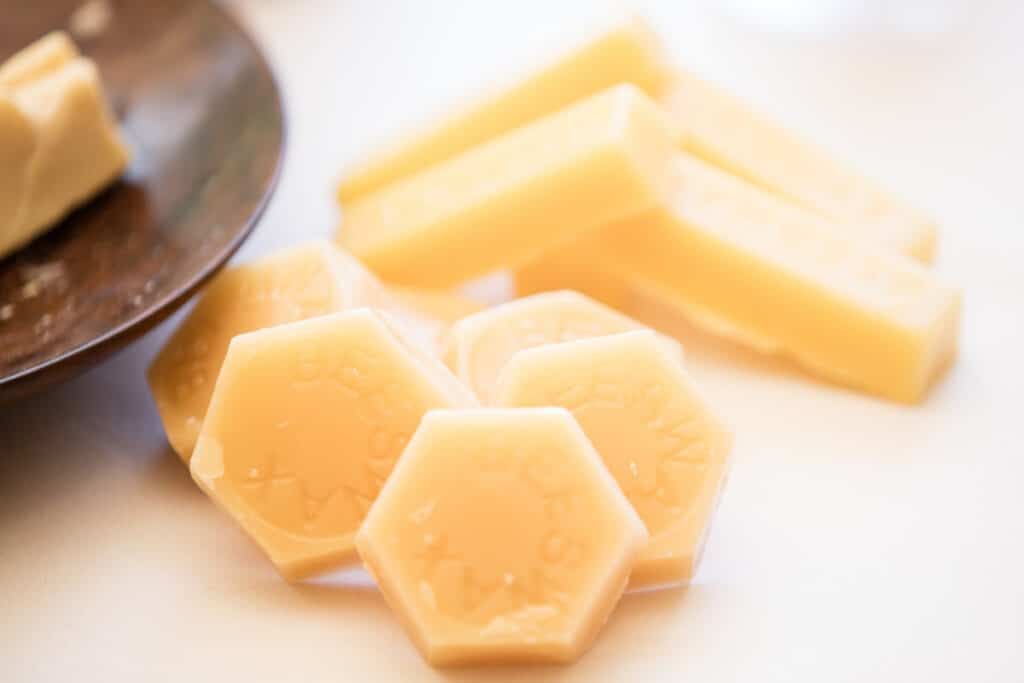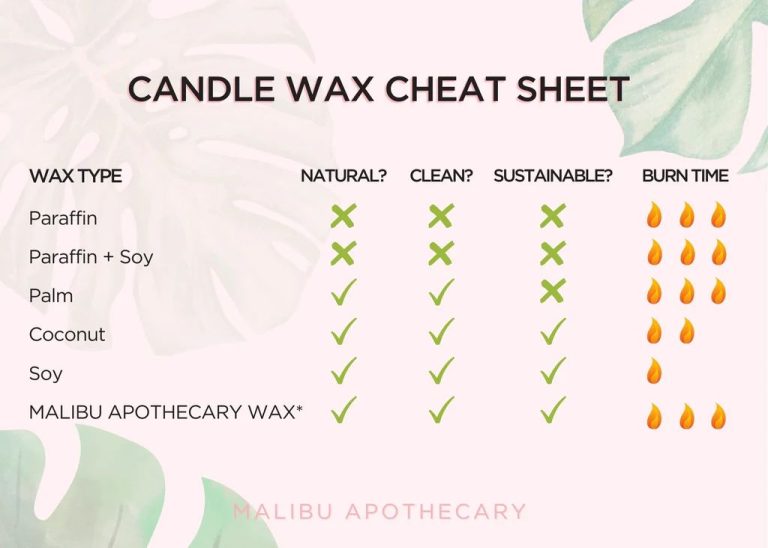What Is The Cleanest Burning Candle Wax?
When it comes to candles, the term “cleanest burning” refers to the wax that produces the least amount of soot and smoke when burned. This is an important consideration because burning candles release compounds and particulates into the air that can be harmful if inhaled. The cleanest burning waxes produce less of these pollutants, making them healthier options.
The three main types of candle wax are paraffin, soy, and beeswax. Paraffin wax is derived from petroleum and is the cheapest option. However, paraffin candles release compounds like toluene and benzene, which are known carcinogens. Soy wax comes from soybeans and burns cleaner than paraffin. Beeswax is considered the gold standard when it comes to clean burning candles. Made by bees, it emits minimal soot and smoke compared to other waxes.
When choosing the cleanest burning candle wax, beeswax and soy wax are better options than paraffin wax. Beeswax, in particular, produces the least amount of air pollutants. This makes it the healthiest and cleanest burning wax for candles.
Smoke Points
The smoke point is the temperature at which a wax or oil begins to produce smoke and give off soot when burned. This temperature is important for candle making because smoke and soot indicate that the wax is burning inefficiently and may release toxins. The higher the smoke point, generally the cleaner the wax will burn.
According to research by Ogunlusi et al., the smoke points of common candle waxes are (PDF) Laminar Smoke Points of Wax Candles:
- Beeswax: 144-149°F (62-65°C)
- Paraffin Wax: 115-142°F (46-61°C)
- Soy Wax: 113-127°F (45-53°C)
This indicates that beeswax has the highest smoke point, followed by paraffin and then soy wax. The higher smoke point makes beeswax the cleanest burning among these three common candle waxes.
Toxins Released
When candles burn, they release various substances into the air that can potentially be harmful. Two primary toxins released are soot and volatile organic compounds (VOCs).
Soot refers to the black particles emitted from the candle wick as the wax burns. These particles contain carbon as well as traces of metals like lead and zinc. Inhaling soot can irritate the lungs and worsen conditions like asthma. Soot can also dirty surfaces in your home.
VOCs are carbon-containing gases that evaporate at room temperature. Common VOCs emitted from burning candles include acetone, benzene, toluene, and formaldehyde. At high concentrations, these substances can cause eye and respiratory irritation, headaches, dizziness or even organ damage over time [1].
The type and quality of candle wax impacts the amount of soot and VOCs released. Paraffin wax candles tend to produce more soot because paraffin is a petroleum byproduct. Soy wax and beeswax candles release less soot. However, soy wax may emit more VOCs compared to paraffin [2]. Beeswax candles produce less soot and VOCs overall.
In summary, all candle wax types release potentially harmful substances when burned, but the amounts can vary. Beeswax candles tend to burn the cleanest in terms of soot and VOC exposure.
Soy Wax
Soy wax is made from soybean oil and is often considered a more natural alternative to paraffin wax. Some of the key pros and cons of soy wax include:
Pros:
- It has a higher smoke point than paraffin wax, usually around 160-170°F (71-77°C) which reduces soot (Joetie Home). This makes it a cleaner burning option.
- It’s made from a renewable resource (soybeans) rather than petroleum like paraffin wax (Everything Dawn).
- It holds fragrances well when blended (Everything Dawn).
Cons:
- It doesn’t hold fragrances quite as strongly as paraffin wax, so scent throw may be reduced (Slatkin & Co.).
- It’s more expensive than paraffin wax.
Overall, the higher smoke point and renewable plant-based source make soy wax one of the better options for clean burning candles. But factors like scent throw and price may also be considerations.
Beeswax

Beeswax is a natural wax produced by honey bees. It has been used in candle making for centuries and is valued for its pleasant honey-like scent when burned. Some key pros and cons of beeswax candles include:
Pros:
- Has a high smoke point of around 400°F, which means it burns cleanly without producing much soot or smoke (1). This makes it a clean burning option.
- Made from a renewable resource that does not harm bees when harvested appropriately (2)
- Natural wax with no artificial ingredients, preservatives or dyes added
- Emits negative ions when burned which may benefit air quality (3)
- Has a warm, natural honey scent
Cons:
- More expensive than paraffin or soy wax (1)
- Limited color and scent options compared to synthetic waxes (2)
- May be prone to frosting or blooming in certain environments (1)
- Can be challenging to work with due to its brittle nature when cool (3)
Overall, beeswax is considered one of the cleanest burning waxes available, though it does come with a higher price tag than other options. Its natural origin and pleasant honey aroma make it a favorite for many candle makers and consumers.
Sources:
(1) https://www.greenerlyfe.com/blog/pros-and-cons-of-beeswax-candles-we-review-the-facts/
(2) https://www.thefarmerscupboard.com/blogs/bees-honey/pros-and-cons-of-beeswax-candles
(3) https://thelobolife.com/pros-and-cons-of-beeswax-candles/
Paraffin Wax
Paraffin wax is derived from petroleum and is the most commonly used candle wax. Some pros of paraffin wax include:
- Low cost – paraffin wax is very affordable compared to natural waxes like soy or beeswax (source)
- High melting point – paraffin has a melting point between 130-150°F giving it a high smoke point and allowing it to retain a good burn pool (source)
- Good scent throw – paraffin disperses fragrance oils better than natural waxes
- Hard finish – paraffin wax dries hard providing a glossy finish
Some cons of paraffin wax include:
- Not environmentally friendly – paraffin is a petroleum byproduct and not biodegradable or renewable
- Toxic emissions – paraffin can release carcinogens and other toxins when burned (source)
- Messy cleanup – spilled paraffin is difficult to clean and stain surfaces
Other Wax Options
In addition to soy, beeswax, and paraffin, there are some other less common waxes used in candle making:
Palm Wax – Made from the fruit of palm trees, palm wax became popular several years ago as a sustainable alternative to paraffin. However, the large-scale palm oil industry has been linked to deforestation and habitat loss. Many candle makers now avoid palm wax due to these environmental concerns.
Gel Wax – A mixture of paraffin and polymer additives, gel wax allows for excellent scent throw and vivid colors in container candles. However, it can be more challenging to work with compared to other waxes.
Bayberry Wax – An all-natural, vegetable-based wax made from the bayberry shrub, this historic wax was used for candles in the 1700s. It has a pleasant, mild aroma when burning but is not widely used today due to scarcity.
Mineral Wax – A byproduct of petroleum refining, mineral wax is sometimes blended with paraffin to raise melting points. It is not recommended for candle making due to its petroleum origins.
Making Cleanest Burning Candles
When making candles at home, it’s important to focus on using ingredients that will lead to a clean and non-toxic burn. Here are some tips for making the cleanest burning candles:
Use natural wax like soy wax or beeswax. Soy wax in particular has a low melting point and no petroleum, which leads to a clean burn (source). Beeswax also burns cleanly and is a renewable resource.
Avoid paraffin wax, which comes from petroleum. Paraffin releases toxins like toluene and benzene when burned (source).
Use cotton, wood, or hemp wicks instead of lead or zinc core wicks. Cotton wicks burn the cleanest.
Add essential oils for fragrance rather than synthetic fragrances, which can release carcinogens and respiratory irritants.
Allow proper wax pooling when burning to avoid soot. Trim wicks to 1⁄4 inch before lighting.
Consider soy blends that incorporate beeswax or vegetable oils for an even cleaner burn.
Making candles with natural, non-toxic ingredients will result in the cleanest burning and safest homemade candles.
Safety Considerations
When burning any candle, it’s important to follow safety precautions to avoid potential risks. Proper ventilation is key – candles should be burned in a well-ventilated room, avoiding direct drafts according to the National Candle Association [1]. Allowing airflow helps prevent rapid or uneven burning, sooting, and dripping. You should burn candles no longer than 1-2 hours at a time, extinguishing them before going to sleep or leaving a room [2].
Additionally, lead-core wicks found in some cheaper candles can release toxic lead fumes when burned, so purchasing high quality candles is advised [3]. Proper candle placement on a stable, heat-safe surface away from flammable materials is also crucial. Following basic safety tips will help ensure candle burning doesn’t negatively impact indoor air quality or create fire hazards.
Conclusion
In summary, the cleanest burning candle wax appears to be soy wax. Soy wax has a high smoke point, releases minimal toxins, and comes from a renewable resource. Beeswax follows closely behind as another clean option that is non-toxic and made from sustainable practices. Paraffin, a byproduct of petroleum refining, produces more smoke and releases concerning compounds when burned.
For those seeking the cleanest burning candle wax, soy is the best choice. Look for 100% soy wax candles made in the USA from American grown soybeans. Beeswax candles are another good option, though may be more expensive or challenging to find. Avoid paraffin candles when possible, or ensure proper ventilation when burning. With the right wax, you can enjoy clean burning candles that provide atmosphere without harmful effects.





